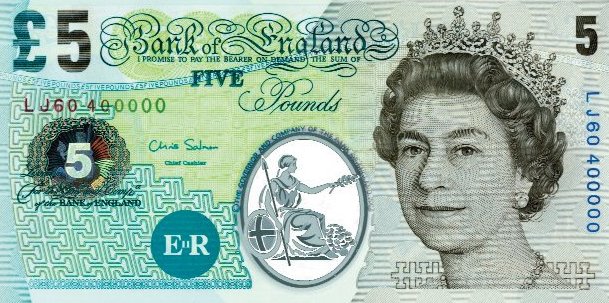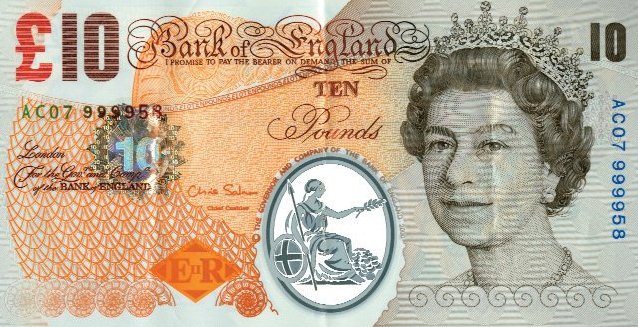Polymer
The Bank of England announced the issue of polymer banknotes as of 2016. A series of regional consultations took place, with a final decision being made in 2014. Trial banknotes were shown to the public, September 11th 2013. Sir Winston Churchill was chosen to appear on the Bank of England £5 banknote, which was issued in 2016. Jane Austen was chosen to appear on the Bank of England £10 banknote issued in 2017, followed by JWM. Turner on the £20 in 2021. Alan Turing is featured on the £50 polymer issued 2021.

Trial for £5 Polymer Bank of England banknote, see through window at centre of banknote.
Prefixes / Serials logged: LJ56 400000 - LJ55 400000 - LJ60 400000 - LJ69 100000

Trial for £10 Polymer Bank of England banknote, see through window at centre of banknote.
Prefixes / Serials logged: AC03 999975 - AC07 999953 - AC10 999943 - AC10 999944 - AC11 999951 - AC13 999950
News Release - Bank of England announces public consultation programme on polymer banknotes
The Bank of England is responsible for maintaining confidence in the currency, by meeting demand with good quality genuine banknotes that the public can use with confidence. Designing new banknotes that take advantage of developments in security features is crucial to delivering this remit. For the past three years the Bank has conducted a research project looking at the materials on which banknotes are printed. In particular, the Bank has reviewed the relative merits of printing banknotes on polymer rather than the cotton paper as at present. From our research, we are confident that printing on polymer would bring considerable benefits to both the durability and quality of banknotes, while also enhancing the strong security which the public associates with Bank of England banknotes. In particular, our research indicates that:
• Polymer banknotes are resistant to dirt and moisture so stay cleaner for longer than paper banknotes.
• Polymer banknotes are secure. They incorporate advanced security features making them difficult to counterfeit and further enhancing the strong security of Bank of England banknotes.
• Polymer banknotes are more durable. They last at least 2.5 times longer than paper banknotes so will take much longer to become “tatty”, improving the quality of banknotes in circulation.
In addition, polymer banknotes are more environmentally friendly and, because they last longer are, over time, cheaper than paper banknotes. Being thin and flexible they fit into wallets and purses as easily as paper banknotes.
In addition to our detailed technical research, the Bank has discussed a move to polymer with key stakeholders in the cash industry, retailers and financial institutions on the technical issues and impact of switching to polymer banknotes. A number of public focus groups have also been conducted across the UK. The initial reaction was positive.
Given that banknotes play a role in everyone’s day to day lives, the Bank is undertaking a public consultation programme before deciding whether to print on polymer. As part of this programme we will be hosting a number of events across the United Kingdom over the next two months, in order to give the public an opportunity to learn more about polymer banknotes and to provide feedback before we make a final decision. Public acceptability is important and we need to factor this into our decision. Our website provides further details about polymer and our programme of events across the UK. The consultation programme will end on 15 November 2013 and the Bank’s final decision, in the light of feedback, will be announced in December 2013. At the same time as running the public consultation programme the Bank will undertake further engagement with commercial institutions which would be affected by a move to polymer.
Commenting, Deputy Governor of the Bank of England, Charles Bean, said: “Polymer banknotes are cleaner, more secure and more durable than paper notes. They are also cheaper and more environmentally friendly. However, the Bank of England would print notes on polymer only if we were persuaded that the public would continue to have confidence in, and be comfortable with, our notes. The results of the consultation programme on which we are embarking will therefore form a vital part of our assessment of the merits of polymer banknotes.”
Smaller banknotes If a decision is made to move to polymer, the Bank will also introduce smaller banknotes. These will be more in line with the size of those in other countries and the larger denomination banknotes will be easier to fit into purses and wallets. This will not alter the current look of Bank of England banknotes: the existing format of tiered sizing will be maintained, i.e. the higher the denomination, the bigger the note. They will also continue to feature Her Majesty the Queen, and to celebrate people who have made a universally-recognised and lasting contribution in their particular field of work. The first polymer banknote would feature Sir Winston Churchill, and the second Jane Austen.”
Chris Salmon, the Bank’s Executive Director, Banking Services and Chief Cashier, said today: “The forthcoming consultations demonstrate the Bank’s commitment to transparency in relation to banknote issues, and are aimed at enhancing awareness and understanding of polymer so that the public can feed into the Bank’s decision in an informed way. I am looking forward to participating in a number of consultation events over the next two months.”
Notes to Editors
1. If a decision is taken to proceed with printing on polymer, this will initially only be for the new-style £5 and £10 banknote. Polymer banknotes would be introduced one denomination at a time, with the Churchill £5 in 2016 at the earliest.
2. The awareness campaign will run until 15 November 2013. The Bank’s decision on whether to move to polymer will be announced in December 2013.
3. Polymer banknotes are manufactured from a transparent plastic film, specially coated with an ink layer that enables it to carry the printed design features of banknotes. The material allows the inclusion of ‘windows’ or clear portions in the design, which enhance protection against counterfeits.
4. As well as reducing printing costs, smaller banknotes will fit more easily into wallets. Smaller banknotes will also reduce issues with cash accepting technology, which are often designed around international currencies which typically have smaller notes. The Bank consulted with the Royal National Institute of the Blind on the proposed size change and they have indicated their support. If the decision is taken to proceed the £5 note will measure 125mm in length and 65mm in height. Each subsequent denomination will measure 7mm longer and 4mm higher than the previous denomination; therefore the £10 note will measure 132mm x 69mm. These will be a little larger than the Euro notes.
5. Further details about polymer, including detailed fact sheets, and a list of dates for our regional visits, can be found at http://www.bankofengland.co.uk/banknotes/polymer/Pages/default.aspx.
6. A short video of Chris Salmon discussing why the Bank is considering polymer banknotes can be found on the Bank’s website: http://youtu.be/80EZ3hp6Jg0.
7. A short video of Victoria Cleland, Head of Notes Division, providing more details about polymer banknotes can be found on the Bank’s website http://youtu.be/RGhgsMd6vBA.
8. Over 50 countries currently issue polymer banknotes. These include Australia, which introduced them in 1988, New Zealand, Mexico, Singapore, Canada and Fiji, which introduced them in 2013.
9. More information on Bank of England banknotes and details about polymer can be found at: http://www.bankofengland.co.uk/banknotes/polymer/Pages/default.aspx.
